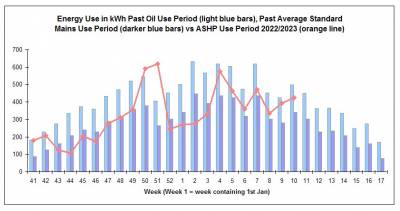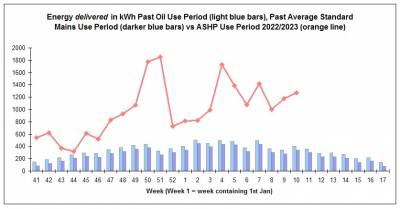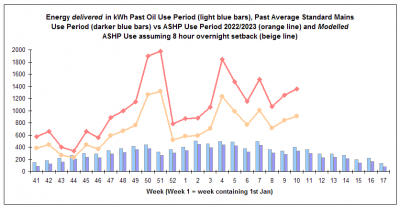A conundrum…
This has had me baffled for a while. I have been logging weekly whole house energy use now I have a heat pump, to compare it with past non-heat pump use. I'm using total house energy use because that is the simplest like for like comparison. There are three relevant periods:
Oct 2012 - Oct 2018: oil central heating, (mostly) immersion heater for DHW. House generally comfy throughout
Oct 2018- Feb 2022: standard mains electricity, ie one or two room Argos type fan and convector heaters (oil tank on the blink). House freezing cold
Feb 2022 to date: air source heat pump. House generally comfy throughout
The data comes from:
(1) for oil period (2012 - 2018) weekly use, annual oil usage distributed over a 30 week heating period in the same proportions as found in (2) below plus average weekly electricity use. I converted litres burnt to kWh burnt by multiplying litres by 10.34.
(2) for standard mains electricity period (2018 - 2022) averaged weekly recorded whole house meter readings
(3) for heat pump period (2022 to date) weekly recorded whole house meter readings oer the current heating season
The values are therefore total house energy use per week, based on averages for pre-heat pump data, single week data for heat pump data.
I then plotted the data:
This shows that my total house energy use (in kWh, not GBP, that's a very different story) was generally higher using oil than it was during the standard mains electricity period and the current heat pump period.
So far so good, but here's the conundrum. Let's convert the energy used to energy produced - ie energy actually delivered to the house - using reasonable efficiencies of 80% for oil, 100% for standard mains electric heaters and 320% for the heat pump:
How can can it be that the heat pump needs to deliver vastly more kWh to the house to achieve broadly the same levels of heating and comfort that I got before with oil CH? Put another way, in effect, a heat pump doubles and trebles my heat loss.
The raw data is pretty robust: they are simple records of oil consumed (based on tank refill dates and volumes) and metered kWh of electricity.
I've said this before, either I am being very thick, or there is something seriously astray with the numbers...
Midea 14kW (for now...) ASHP heating both building and DHW
Just a couple of thoughts, how did you arrive at a COP of 3.2 for the heat pump, not unreasonable, but is it measured or estimated. Week 51 seems to be a massive outlier, any idea why?
House-2 bed partial stone bungalow, 5kW Samsung Gen 6 ASHP (Self install)
6.9 kWp of PV
5kWh DC coupled battery
Blog: https://thegreeningofrosecottage.weebly.com/
Heatpump Stats: http://heatpumpmonitor.org/system/view?id=60
Good evening,
Are you able to share the full spreadsheet with the Data?
many thanks
Drew
@cathoderay it seems odd to me. It seems stupid but are you sure the power isn't the delivered heat? My power in kw is roughly 1/5 what it was on gas. Something in your numbers doesn't make sense. Or your house must feel like the med.
Posted by: @bontwoodyJust a couple of thoughts, how did you arrive at a COP of 3.2 for the heat pump, not unreasonable, but is it measured or estimated. Week 51 seems to be a massive outlier, any idea why?
Where did the 3.2 come from? Good question, I should have said. It is about what my COP has been for the whole of this heating season, ie from beginning of Oct 2022 to date, calculated as total energy in divided by total energy out over this period.
Week 51 (and perhaps one or two on either side) are outliers. I think this is probably a Christmas effect, change in behaviour related to the holiday period.
Posted by: @drew-paAre you able to share the full spreadsheet with the Data?
Yes, but it a bit messy and cumbersome at the moment, a bit like I also use it for writing casual notes-to-self and shopping lists. I'll try to tidy it up a bit and post it. But the really important thing is to understand where the data comes from, without that, the numbers are meaningless. The starting post gives most of the information: the oil heating period data comes from historical receipts for oil deliveries, most years I did one mega-fill in the summer, which would then see me though the coming heating season, until the next mega-fill the following summer. That makes annual consumption easy to determine (same as filling your car up, diving a long measured distance, and then filling it up again to get fuel consumption). I then distributed the total number of litres over the heating season in the same proportions per week as that seen during the only using standard mains electricity period, and then multiplied by 10.34 to convert litres to kWh (one litre of standard heating oil/kerosene contains 10.35 kWh of energy). Lastly, I added my weekly baseline electricity usage, based on a decade long time series of old electricity bills. It has been remarkably constant over time.
The second standard main electric heater period is simply weekly whole house meter readings. I then calculated weekly averages for the four winters (2018/19, 2019/20 ,2020/21 and 2021/22, but with the heat pump installed and running by Mar 2022) that I had that form of heating in place.
The heat pump period data is again weekly whole house meter readings over the current heating season. It is therefore totally independent of any Midea influenced estimates of energy consumption, which I know are not very accurate, as I also have a dedicated meter that supplies the heat pump. Usually, but not always, the Midea estimate of energy used is an under-estimate of that actually used, but not by a huge percentage, maybe around 5%.
What the above means is that the charts shows total house energy consumption (regardless of fuel being used), not just heating use, but as the baseline non-heating use is remarkably constant, any variation we see is pretty much all down to heating use. As it is always total energy use, we also know we are comparing like with like.
The second chart is simply the first chart adjusted for efficiencies for each system to give the total weekly energy output, ie that actually delivered to the house.
Posted by: @bataltoit seems odd to me. It seems stupid but are you sure the power isn't the delivered heat? My power in kw is roughly 1/5 what it was on gas. Something in your numbers doesn't make sense. Or your house must feel like the med.
It seems odd to me too, I can't get my head round it, hence this thread and its title!
Is your energy use (recall this is about energy use, kWh, not power, kW) really now 1/5 of what it was when you used gas? If you have bills going back far enough, can you calculate your average annual total energy use under gas, and see that it is five times your current total energy use from all sources ie including the solar element as well?
But the real conundrum at the heart of this thread is the apparent nonsense that a kWh of heat pump delivered energy is half or at times less than half as effective as a kWh delivered by oil heating. To keep the house in a steady temperature state, I need twice or more than twice the number of heat pump delivered kWh than I did with oil heating. It defies the laws of physics, and usually anything that does that is wrong! Some things I have considered:
(a) during the oil and heat pump periods, the house has almost always been comfortably warm - neither too hot nor too cold. Assuming the basic physics behind heat loss calcs is sound, and that recent (last decade) winters haven't when taken as a whole been hugely different in ambient temps, then in general terms the house must be consuming the same amount of energy now as it was during the oil heating period
(b) but that is not what the charts show. The second one shows most of the time it needs at least twice, often a lot more than twice, the number of heat pump kWh than it did with oil heating
(c) given roughly equivalent steady states for indoor and outdoor temps over the oil and heat pump periods, then, if the normal efficiencies apply, then to maintain a steady indoor temp state, I should very roughly use about one third as much energy in under the heat pump. But that is not the case, I am very roughly using about the same total using a heat pump as I did under oil (first chart)
(d) has something changed that could account for this? There are two possible candidates:
(i) insulation levels: but these have gone the other way, the house is now better insulated than it was, so energy use should be less than it was. Put simply, better insulation, and so lower energy loss, cannot explain higher energy use
(ii) timed heating vs always on heating: the oil boiler was on a timer, the heat pump isn't. In past posts I have lamented the fact I can't have an overnight setback, because the heat pump can't recover from the setback in a reasonable period of time. This does mean I consume energy overnight with a heat pump that I did not consume using oil, and this use is not trivial: last night, admittedly a cold night, for example, it was two to three kWh per hour over what would have been the oil CH off period. Could this explain the high heat pump energy delivered?
Perhaps, perhaps not. What if (which means I am modelling something, and I inherently distrust 'what if' modelling over empirical evidence) my heat pump could manage an overnight setback? What if it could do as the oil boiler usually did, be off between say 2200 and 0600 hours? That is 8 hours, or one third of a 24 hour period. What does the second chart look like with another line added, showing energy delivered with the heat pump off between 2200 and 0600 hours.
To 'model' this, I have simply reduced the heat pump energy consumed by one third (because it is off for 8 out of every 24 hours), and then applied the efficiency figures as before. The beige line represents this modelled usage pattern:
Running the heat pump, were it possible to do so without a recovery penalty, with an overnight setback does need less total energy delivered (and it is actually a very worthwhile saving, which is why I so lament not being able to use one), but it is still markedly greater than that needed under oil heating.
The other rather alarming possibility is that the whole COP/efficiency game is a chimera, perhaps even a nonsense. Bear in mind the second chart is not real world measured data, it is modelled data, based on what if assumptions: what if the efficiency of an oil boiler is 80%, what if the efficiency of a heat pump is 320% etc etc? What if it is all complete nonsense, dreamed up by snake oil salesmen?
After all, the first chart shows something that makes inherent sense, I need to burn roughly the same amount of energy, whatever the fuel/heating system, to heat my house to a comfortable temperature. We only get into the absurd when we introduce efficiencies.
Lastly, there is another clue that the whole heat pump efficiency thing may be nothing but smoke and mirrors. My heat loss in round figures is 12 kW (power), which equates on standard assumptions (<=link) to around 24,000 kWh (energy) per annum. My EPC has roughly this figure on it, 23,878 kWh per year for space heating (water heating is given as 2957 kWh per year, but this is a huge over-estimate, I don't use anything near that amount, according to the Midea app I use about 420 kWh per year). Using oil based heating I actually burnt around 12,000 kWh to get a comfy house, and that is a fact (real data, unlike the EPC). Yet the Midea wired controller reports that it has delivered a total lifetime energy of 29,232 kWh. Where did the excess 5,000/18,000 (depending on comparator) kWh go? Up the chimney as smoke, leaving behind the wired controller as a mirror on the absurd?
The conundrum continues...
Midea 14kW (for now...) ASHP heating both building and DHW
@drew-pa - here's the file. It is rather brutal and not very pretty, but it does the job. I've tried to add enough notes to make it clear what I did, and the calculated cells will be self-explanatory by way of the formulas they contain:
I've also gone back and brutally analysed my oil purchases (actual historical delivery notes and invoices) and usage for 2010 to 2018. The tank was filled once a year in the summer, bringing the oil level up to usually the same height, 1700mm from the bottom of the tank as measured on the tube gauge on the front of the tank (2014 and 2015 were the exceptions former was a bit higher, latter was a bit lower). This means that in most years the volume dispensed equalled what I had used in the past year. The average volume was 931 litres, which is a bit less than I used in the chart calculations (1000L), so the light blue bars should be a little bit shorter.
Midea 14kW (for now...) ASHP heating both building and DHW
@cathoderay this link will take you to my messy spreadsheet. The tab you are looking for is Bill Estimates. You'll see tracking monthly from 2019 onwards.
@batalto - interesting. Here is my reading of the numbers.
Units: we are looking at energy consumption and as we are looking at energy, we use kWh (spreadsheet I think often has kW when it should be kWh).
Metering: electricity meters record kWh. For non electric fuels (oil and gas), we meter volume consumed, and then convert that to kWh, using a conversion factor: burning 1 litre of CH oil produces 10.34 kWh, burning 1 cubic foot of gas produces 0.2931 kWh (does vary a bit but that is a reasonable average value). Without factoring in efficiency etc, 1000 litres of oil produces 10,340 kWh, 1000 cu ft of gas produces 293.1 kWh.
As a vague sanity check, what does a 'typical' house consume (in kWh)? Ofgem produce figures annually ("TDCVs" Typical Domestic Consumption Values), and their estimate for a high use (which I have assumed you are, given your floor area) gas fuelled property is 17,000 kWh per year. As ever with Ofgem, nothing is transparent, but lets assume consumption means what it means, amount consumed
Using the above conversion factor in reverse, to get 1 kWh we need to burn 3.4118 cu ft of gas, we can guesstimate you might burn around 17,000 x 3.4 = 57,800 cu ft of gas per year. This is just a ball park sanity check number.
Now let us turn to the Bill Estimates spreadsheet.
In cell D33 we have a figure of 23,797 (I think that's kWh, not kW as shown) which appears to be the gas you were billed for in in 2018/19 ("EDF Full year use (2018/2019)"). Using the reverse conversion factor, that's about 81,190 cu ft.
In cells Y5 and Y6 we have your 2020 gas figures, 1,095 cu ft consumed (derived by summing monthly use, in turn derived by subtracting this months reading from last months reading), or 34,683 kWh. Something is clearly very wrong: 81,190 cu ft in 2018/19, 1,095 cu ft in 2020???
The problem is an Imperial gas meter doesn't read in cu ft, it reads in 100s of cu ft. You burnt 109,500 cu ft of gas in 2020, not 1,095 cu ft. This is in fact taken into account in the byzantine official calculations shown in cells D3 to E8 in the conversion of cu ft to cubic metres step. As a sanity check, using the conversion factor I gave earlier (0.2931) 109,500 cu ft of gas equates to 32,094 kWh, which is in the same ball park as the spreadsheet's figure.
However, even after allowing for lockdown effects (higher home heating bills etc) it seems 2020 is very much an outlier, when you used almost 50% more energy than you did in 2018/19. Your 2020 figure is also getting on for twice OGEM's TDCV for a high use house (109,500 vs 57,800 cu ft). I suppose it's possible, but... Or maybe Castle Batalto is very toasty.
It would be very useful to go back further in time, and look at total annual gas use before 2018/19, if you still have the bills. My guess is your typical annual gas use and so heating use (ignoring cooking etc) will be nearer 24,000 kWh, rather than ~33,000 kWh. Let's stick with 24,000 kWh (and in passing note it is notably higher than an average high use household).
You had the heat pump installed in mid 2021, making that a complicated year to assess, so let's forget it.
In 2022 I think I am right in saying all your heating came from your heat pump, and, regardless of where the electricity came from, rows 27 to 29 have the monthly and annual totals for ASHP energy consumed, ie read from a dedicated meter supplying only the heat pump. If they are Midea app based they are suspect (it tends to under report actual use, see posts passim). The spreadsheet shows an annual total use of 7,012 kWh (not kW as shown).
This does make sense, but you are using about one third not one fifth as much energy for heating (7,012 vs 24,000 kWh). If we factor in typical efficiencies (say 80% for gas, 320% for an ASHP), the figures for heat delivered become 19,200 kWh and 22,438 kWh. They are not wildly out, as mine are, but there is still a bit of a conundrum, because it seems that somehow a gas produced kWh is more potent than an ASHP produced kWh (only need 19,200 gas produced kWh to do the work that 22,438 ASHP kWh can do). But that variation may well be just temporal variation or measurement error.
Midea 14kW (for now...) ASHP heating both building and DHW
@cathoderay in 2019 we basically doubled the size of our house - we added a second floor. There is literally no point going back in time as the comparison would be pointless.
Also my son was born in 2018 and my wife started looking after our kids at home full time. This means our use profile has totally changed from a house empty all day, to a house fully used 24/7. The gas was on setback during the day and night, which isn't the case with the heat pump.
Yes the house is toasty - my wife hates the cold
@batalto - that all makes sense. It's also a very good example of the problems we have to deal with in real world data, nothing ever stays the same!
Midea 14kW (for now...) ASHP heating both building and DHW
One question if I may, where was your old oil boiler located; within you home or in an outbuilding?
- 26 Forums
- 2,356 Topics
- 53.4 K Posts
- 256 Online
- 6,017 Members
Join Us!
Worth Watching
Latest Posts
-
RE: Octopus Cosy Heat Pump Owners & Discussion Thread
@kevh with the Cosy 6 I know it definitely goes to arou...
By HarrisonC , 12 hours ago
-
RE: Setback savings - fact or fiction?
@cathoderay yes I am familiar with SQL. Interesting num...
By RobS , 13 hours ago
-

Parsnip, Bacon & Coconut Milk Soup
First let me say, I am only a cook because I am human a...
By Toodles , 13 hours ago
-

RE: Controlling Daikin Altherma via P1P2 and Home Assistant
@weoleyric Oh Dear, I don’t think I am going to be of m...
By Toodles , 14 hours ago
-
RE: Electricity price predictions
Ben Watts posted on LinkedIn that he had updated this w...
By Judith , 19 hours ago
-

RE: The good, the bad and the not that great – my heat pump installation
Small update, Emailed and Spoke to Midea UK and they ...
By Burtis , 19 hours ago
-
RE: Solis S6-EH1P8K-L-PLUS – Why I Chose It and What I’ve Learned So Far
@bash Octopus does charge for the admin. The process al...
By Batpred , 19 hours ago
-
RE: External pipework insulation
@transparent HI all The products you mention are ver...
By David Smith , 19 hours ago
-
RE: New Fogstar 15.5kWh upright solution
Issues still under investigation by Solis... Fogstar ...
By Batpred , 19 hours ago
-
RE: Who's your electricity provider and what's your tariff?
I agree, the consumer is not being properly represented...
By Batpred , 20 hours ago
-
RE: Advice on internal circulation pump noise
Thanks @mikefl - I'll maybe have a look at the lock-shi...
By jtg , 2 days ago
-

RE: Heat Pump Heats the House… But It’s Not Cosy. Emitter Changes or System Tweak?
@toodles interesting suggestion, thanks. I will try to...
By GrahamF , 2 days ago
-
RE: Mitsubishi Ecodan Auto Adaption trial to stop cycling.
The interval you talk of, i think, will be 60min for an...
By F1p , 2 days ago
-
Agree with @majordennisbloodnok on the setbacks. We hav...
By ChandyKris , 2 days ago
-

RE: Speedcomfort radiator fans
@deltona the way the links were added broke the page. A...
By Mars , 2 days ago
-

RE: Refrigerant R32, is it now banned in the EU from 1st Jan 2027 for monobloc ASHPs?
This has been delayed from what I believe to be this ye...
By dgclimatecontrol , 3 days ago
-
RE: Are We Sleepwalking Into Another Race to the Bottom?
this is why I provided current flow temperatures in the...
By ksim , 3 days ago
-

RE: Why Millions of UK Homes Struggle With Heat Pumps
There's many homes that would be quite a disruption for...
By dgclimatecontrol , 3 days ago
-
RE: Ecodan unable to hit legionella target temp - what's the consensus?
@rhh2348 ...maybe this option is what you want? Alter...
By benson , 3 days ago








